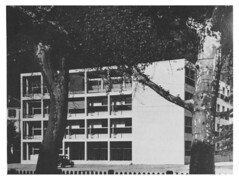
As I've mentioned previously, the Big 3 were not solid fortresses of ideology and often complimented and adopted aspects of one another in the struggle for hegemony. For one such example, consider the Casa del Fascio designed by Giuseppe Terragni as a municipal administrative building of the Fascist regime. Terragni was a member of the architectural association Gruppo 7 who, like the Futurists, represented the most avant garde elements of Italian Fascism. Their style was called Italian Rationalism and was essentially a school of the International Style which was to later dominate the architectural landscape of the victorious postwar West. As Diane Ghirardo writes in her essay Politics of a Masterpiece: The Vicenda of the Decoration of the Façade of the Casa del Fascio, Como, 1936-1939:
Because Fascism offered itself as an entirely new and modern phenomenon, it could readily align itself with modern architecture, amply buttressed by references to the "romanitá" and "mediterraneitá" that these contructions presumably projected. In practice, this meant that architects such as Terragni, Adalberto Libera, Mario de Renzi, and Giuseppe Pagano could design solely within their own aesthetic restraints, confident of no official interference and, occasionally, as with Sabaudia and the Stazione S. Maria Novella in Florence, with polemically active support from the regime.
Today the Casa remains very modern looking and could easily be mistaken for a trendy office building or even an affordable boutique hotel.
As Sheri Berman describes in The Primacy of Politics the regime also established, "the hugely popular Dopalvoro, or Leisure-Time Institute, which provided large numbers of Italians with opportunities for education, sport and recreation." Effectively this was the State-sanctioned and directed pursuit of happiness and leisure. While still authoritarian, this is not exactly the drab and grey version of fascism were are normally presented with. Of course, this was when the political movement was also rather independent and Mussolini had yet to become a dupe of the Nazis whose relation to art and architecture were rather reactionary and corny when compared to their Italian allies. Then again, the subtle homoerotic imagery of some of it may hold some relevance for those who get their kicks from uniforms and orders.
So in closing, there was much about the New Italy which was sleek, avant garde, urbanite and sexy. And while not wanting to sound like that slimeball Jonah Goldberg, much they had in common with their liberal opponents.

No comments:
Post a Comment